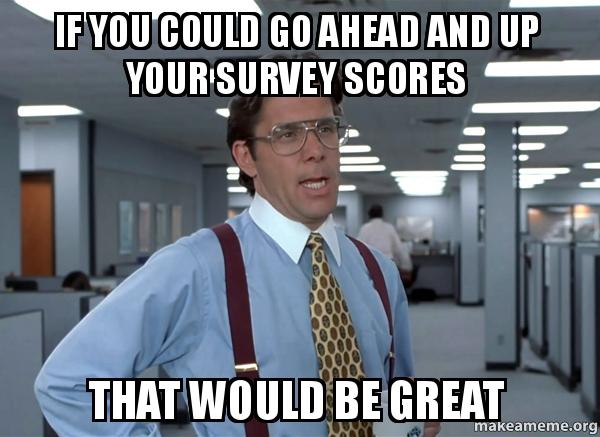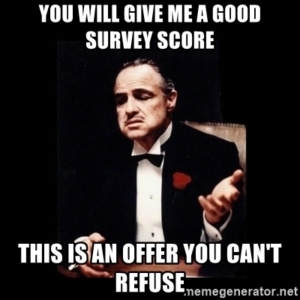
We’re early in Customer Experience (CX) capability development, and I absolutely love it! We’re discovering the best practices that our successors will take for granted; “of course that’s how you do it.”
Unfortunately, being in this early stage means that some “best practices” aren’t. Some actually hinder the goal of improved CX – to create loyal customers who love your brand and come back time and again.
One “best practice” that can create a terrible customer experience is paying employees to achieve good NPS, or Customer Satisfaction, scores. This needs to stop.
The idea comes from a good place. We know that incentives drive behavior. The research is clear that, even though we all feel we’re immune to it, pay sure seems to drive everybody else, so why wouldn’t you pay people to improve customer scores? Especially if we know (or believe) that these scores link with true loyalty.
It’s the law of unintended consequences. Paying people for better NPS scores can result in a downgraded customer experience even when those scores improve.
Paying for scores is using a sledgehammer – a big, heavy tool without nuance. Incented employees will go to great lengths to receive that pay. We’ve all had this car dealership experience: “is there any reason you couldn’t give me a 10?” It gets worse! I’ve even been told, “we measure our success through survey scores, and I get in trouble with my boss if I don’t get a 10,” and “my performance is measured by your scores for overall satisfaction, so please consider that when filling out your survey.” This last example was from a Microsoft support rep – it happens everywhere!
 But none of these are as blunt as the tactic used by our local ABRA Auto Body, who gave me a “sample survey” so I’d know how to fill mine out.
But none of these are as blunt as the tactic used by our local ABRA Auto Body, who gave me a “sample survey” so I’d know how to fill mine out.
The problem is that, while there may be a link between NPS scores and business outcomes (which is an open question), it’s difficult for an employee to draw a straight line between specific behaviors and a customer’s likelihood to recommend. For example, should a call center rep ask about the weather and the customer’s kids to build an emotional connection? Or should they focus just on the matter at hand to decrease effort? Either is a valid approach, which means reps will react differently, and your customers will never know what to expect.
Paying for survey scores drives action. But is it the best action for your customers? Assuming your goal is to improve business outcomes like repeat customers and increased share of wallet, then incenting employees to beg for scores isn’t the best method.
Of course, this probably isn’t your call. But it needs to be listed as an option. If you do this, you need to be careful. You don’t want to send the message “Customer loyalty is no longer important to us, so we’re going to stop paying for it.” You also don’t want to create a big pay cut. Instead, reallocate the money towards items that will reward employees for improved customer results, perhaps training or finding something to pay them for instead of a comprehensive, high-level CX score. For example, you could
You have to be careful to select the right metric and provide the management structure to ensure you get the right behaviors (see Wells Fargo). The wrong business metric drives the wrong behavior just as bad survey incentives do. If you’ve ever been on the line with a call center agent who’s managed to Average Handle Time, you know what I mean. Incenting somebody to get off the line as quickly as possible ensures that some will hang up before the problem is fully resolved. This creates both an annoyed customer and increased call time as the next agent has to read through what was done the first time. Higher costs and more frustrated customers are the risks of doing this wrong, so be sure the business metrics align with a customer’s interest. Number of calls isn’t right – but perhaps number of repeat calls on the same topic is. Of course, ideal business metrics vary by role, which also makes it more challenging. If you do want to use survey scores, you could
I’m not wading into the “Is NPS/Customer Satisfaction/Customer Effort Score the right metric” discussion, although I’ve written on that plenty. Instead, I recommend focusing incentives on more actionable scores. Do you do a driver analysis on your surveys (this is a statistical methodology to see which questions most drive the item of interest, such as NPS)? If so, look at these to find which are most actionable. For example, if the top factor driving NPS is “sales rep knowledge,” then incenting on this will ensure reps learn your product well. Yes, there may still be some unintended consequences, as reps may go into more detail than clients want. But at least this is aligned with what customers want and need, and it’s easier to manage.
On this last front, when I worked in the field of employee engagement, we knew that incenting managers on their team’s engagement scores drove all kinds of bad behaviors. Stores would put up “5” balloons during the survey time, for example. Incenting them instead on “in the last year, did your manager take action to improve based on your last engagement survey” was harder to game and created the right kinds of behaviors. Can you do something similar?
Paying people to make customers happy makes a lot of sense and can certainly work in some situations, but you risk putting your teams in situations where it’s a whole lot easier to take shortcuts and just ask for the scores.

